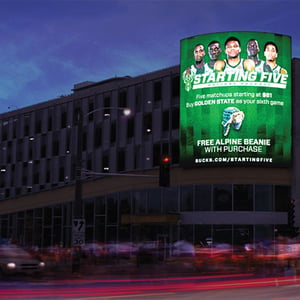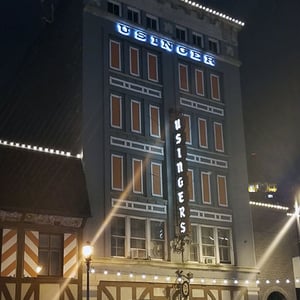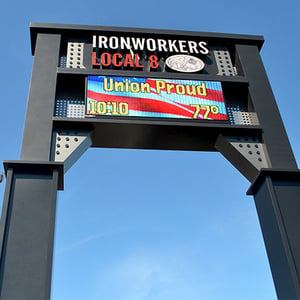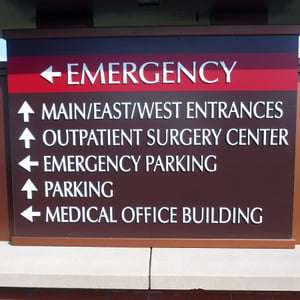With so many design options, it’s easy to forget the basic reasons for a business sign. Recent studies by the Sign Research Foundation and the University of Cincinnati confirmed that signs can either draw or deter traffic and even infer the quality of your products and services.
In their annual BrandSpark/Better Homes and Gardens American Shopper Study, the University of Cincinnati (UC) surveyed over 60,000 United States consumers, ages 18-65+. In the survey, consumers revealed the effect of signage quality, the use of signage to infer quality and the usefulness of indoor and outdoor signage for new information. The study also examined the effects of good design and size on the legibility of signage.
Above all, the study reveals that regardless of age, gender or education level, most consumers take a pass on businesses with poor signage. Things like size, color, lighting, even surrounding visual distractions, all make a difference for passing motorists.
With all the visual noise, how do you create and implement a sign strategy that sets you apart but doesn’t turn off or confuse your audience?
The Trick of Differentiation
The UC survey showed that a whopping 75.2% of those surveyed notice outdoor signage of a new or unfamiliar business. Even more astounding is the 85.7% who use that same signage to infer a business personality/character. And, 62.7% of those surveyed agreed that sign design and aesthetics are important and need to play against the backdrop of other signage in a business district.
Those are hefty numbers that support the case that your outdoor business signage is one of the most important business investments you’re going to make.
Not only do you have to stand apart in a crowded marketplace, but you need to do it in a way that complements the surrounding business landscape as well. That doesn’t mean you blend in; it means you play against the surrounding landscape so that you stand out without being jarringly overt.
A quality sign company can help you navigate the process of design, manufacture, and installation of your new business signage. In the meantime, here are five goals you should consider when creating business signage.
5 Goals of Your Business Signage
1. Attract: Your signage is your business billboard, your calling card, your greatest advertisement. It is the first thing a consumer notices about your business. And they can make a snap judgement as to whether they want to engage with you based on your signage, among other things. Over 85% of the consumers surveyed by the University of Cincinnati agreed that business signage conveys the personality or character of a business.
In a separate survey conducted in 2012 by FedEx, researchers found that consumers believe that business signage indicates the quality of the product or services offered.
Good business signage can indicate a higher level of professionalism to the consumer. Lack of intention with your business signage leaves the overall impression of your business solely in the hands of the consumer. The customer experience starts before a customer ever makes a purchase. Control as much of that experience as possible with signs that look professional and are visible and eye-catching amidst the landscape.
2. Identify: Your signage identifies your brand in the most overt way. From the design of the logo to the colors and materials, your business sign is one of the most visible and overt displays of who you are to the consumer. When your brand is carried throughout your sign strategy, consumers gain familiarity and trust. Trust deepens as they interact with your brand. A long as they consistently receive a quality experience, they’ll go from being a consumer of your product or service to being a brand ambassador. They will entwine their identity with yours, bringing more and more business to you.
Brands change, evolve and grow. Brands may merge, creating new brands and necessitating new signage. Still others may expand to offer additional services as in the case of a municipal campus that houses a police department, library and city hall.
You may need to change your signage as your business evolves. What is most important to remember is that the customer has loyalty to you and your quality, but they don’t have to remain loyal throughout the change. Help the customers through brand changes by carrying elements – colors, logos, etc. -- into the next iteration of your brand signage. Even the most recognizable brands change logos and signage to reflect brand changes. For example, Nike and its iconic “swoosh” became so recognizable that the company dropped the word “Nike.”
3. Inform: Your customers need to know – about sales, about what they’ll find at your location and about you. Indoor and outdoor signage are among the most effective methods of informing customers of new products and sales. Signage can be blatant and clear in ways that no other means of communication can.
Whether you are creating brand signage or specific sale signage, your signs must be legible and well placed so that your customers know where you are, what they’ll find at your location, and why they need to stop.
The UC survey found that 58% of those surveyed preferred variations among aesthetic uniformity. While they were attracted to a uniform branded look for all signage within a business, they found that when sign design varied slightly, their purpose was easier to identify. Varying signage within a uniform brand can help patrons understand at a glance when they are looking at a limited sale sign or a regular pricing sign.
4. Motivate: Signs, like all other forms of advertisement, have one ultimate goal: to turn a potential customer into a money-spending, brand-loyal regular patron. Your signs need to motivate the potential customer to take the next step toward the sale. Your messaging should lead a potential customer through the buyer’s journey and down the sales funnel. Visibility and design of your business signage can affect that journey and its potential sales. signs must be legible and well placed so that your customers know where you are, what they’ll find at your location, and why they need to stop. The UC survey found that 58% of those surveyed preferred variations among aesthetic uniformity. While they were attracted to a uniform branded look for all signage within a business, they found that when sign design varied slightly, their purpose was easier to identify. Varying signage within a uniform brand can help patrons understand at a glance when they are looking at a limited sale sign or a regular pricing sign.
In the 2012 Fex Ex survey, over 50% of the total respondents noted that poor signage deterred them from patronizing a business. In another survey, the University of Cincinnati found that consumers don’t have the patience for signage they can’t read or that doesn’t provide the correct information.
Don’t leave all the power in your potential customer’s hands. Guide them with a series of calls to action that bring them in. Consider their pain points as they interact with your brand. Are you located in a rural or urban area? What type of visual clutter do they have to decipher before they get to your sign? Does the customer know where to go next or what to do? Should they buy now because the sale ends tonight or do they have time to come back when its more convenient?
Though your sign strategy should rely upon multiple channels of exposure to your product or service, such as a website or an advertisement, a single exposure to your sign can make or break the entire journey.
5. Direct: Signage can direct your customers to a specific location on your business campus such as a building or an entrance. You’ll want to keep that path as frustration free as possible. Inform and direct every step of the way from the street to the back of the store.
Consider parking lot directional and location identifiers that let patrons know where they have left their car. Proper signage can also direct patrons to you and back to their car once they are in the building. Things are done differently today as they were in the past, but hospitals may have been the first to understand the importance of on-site navigation to move patients to the correct department or office. Who remembers following a colored line from the check in desk to the lab?
Think of directing your customers like a providing a good hiking trail. A well-marked trail can lead hikers through a wonderful experience, filled with watering holes, trail side education and vistas for resting weary feet. A poorly marked trail can misinform hikers, leading them astray and stranded on an abandoned and flooded foot path to nowhere. In the first case, you’ve got a repeat customer who is likely to bring a friend. In the second, you’d better start looking for the next hiker.
For more information on sign design, sign types, electronic message centers and installation services, contact the Lemberg Signs and Lighting at www.LembergElectric.com/signs or call 262.781.1500. Request a free estimate now.
